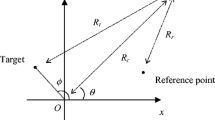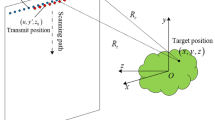Abstract
This paper deals with the application and the performance analysis of a microwave tomography approach for Forward-Looking Radar (FLR) bistatic illumination. The imaging problem is faced by adopting an inverse scattering algorithm based on an approximated model of the electromagnetic scattering. In particular, the Born Approximation is used to describe the wave–material interaction and the targets are assumed to be embedded in a homogenous medium. The adoption of a simplified model of the electromagnetic scattering allows us to analyse how the reconstruction capabilities depend on the measurement configuration. An investigation of the resolution limits in the FLR case is performed and some numerical results are provided in order to show the effectiveness of the proposed approach in cases resembling the ones occurring in real situations.








Similar content being viewed by others
References
Balanis, C. (1989). Advanced engineering electromagnetics. New York: Wiley.
Balke, J. (2008) SAR image formation for forward-looking radar receivers in bistatic geometry by airborne illumination, In Proc. IEEE Radar Conf, RADAR ‘08, May 2008, pp. 1–5.
Bertero, M., & Boccacci, P. (1998). Introduction to inverse problems in imaging. Bristol: Institute of Physics Publishing.
Bradley, M.R., Witten, T.R., Duncan, M., McCummins, R. (2003), Mine detection with a forward-looking ground-penetrating synthetic aperture radar, In Proc. SPIE, 5089, 334–345.
Chew, W. C. (1995). Waves and fields in inhomogeneous media (2nd ed.). New York: IEEE.
Espeter, T., Walterscheid, L., Klare, J., Brenner, A. R., & Ender, J. H. G. (2011). Bistatic forward-looking SAR: Results of a spaceborne-airborne experiment. IEEE Geoscience and Remote Sensing Letters, 8(4), 765–768.
Fortuny-Guasch, J. (2002). A novel 3-D subsurface radar imaging technique. IEEE Transactions on Geoscience and Remote Sensing, 40(2), 443–452.
Franceschetti, G., Iodice, A., & Riccio, D. (2014). Forward-looking synthetic aperture radar (FLoSAR): The array approach. IEEE Geoscience and Remote Sensing Letters, 11(1), 303–307.
Gennarelli, G., & Soldovieri, F. (2013). A linear inverse scattering algorithm for radar imaging in multipath environments. IEEE Geoscience and Remote Sensing Letters, 10(5), 1085–1089.
Giannopoulos, A. (2005). Modelling ground penetrating radar by GprMax. Construction and Building Materials, 19(10), 755–762.
Harrington, R. F. (1993). Field computation by moment methods. New York: Wiley.
Kapoor R., Ressler, M.A., Smith, G. (2000), Forward-looking mine detection using an ultrawideband radar, Proc. SPIE 4038, Detection and remediation technologies for mines and minelike targets V, 1067.
Kositsky, J., Cosgrove, R., Amazeen, C., & Milanfar, P. (2002). Results from a forward-looking GPR mine detection system. Proceedings of SPIE, 4742, 206–217.
Leone, G., & Soldovieri, F. (2003). Analysis of the distorted Born Approximation for subsurface reconstruction: truncation and uncertainties effect. IEEE Transactions on Geoscience and Remote Sensing, 41(1), 66–74.
Persico, R., & Soldovieri, F. (2004). Reconstruction of a slab embedded in a three layered medium from multifrequency data under Born Approximation. Journal of Optical Society of America, Pt. A 21(1), 35–45.
Persico, R., Bernini, R., & Soldovieri, F. (2005). The role of the measurement configuration in inverse scattering from buried objects under the Born Approximation. IEEE Transactions on Antennas and Propagation, 53(6), 1875–1887.
Persico, R. (2006). On the role of measurement configuration in contactless GPR data processing by means of linear inverse scattering. IEEE Transactions on Antennas and Propagation, 54, 2062–2071.
Persico, R., Soldovieri, F., & Utsi, E. (2010). Microwave tomography for processing of GPR data at Ballachulish. Journal of Geophysics and Engineering, 7(2), 164–173.
Persico, R. (2013). Introduction to ground penetrating radar: inverse scattering and data processing, IEEE Press Series on Electromagnetic Wave Theory. New York: Wiley.
Ren, X., Sun, J., & Yang, R. (2011). A new three-dimensional imaging algorithm for airborne forward-looking SAR. IEEE Geoscience and Remote Sensing Letters, 8(1), 153–157.
Ribalta, A. and M.A. Gonzalez-Huici (2013), Backprojection algorithm for subsurface radar imaging: computing the round-trip time delay. Proceedings of IEEE International Geoscience and Remote Sensing Symposium.
Soldovieri, F., Hugenschmidt, J., Persico, R., & Leone, G. (2007). A linear inverse scattering algorithm for realistic GPR applications. Near Surface Geophysics, 5(1), 29–42.
Soldovieri, F., Lopera, O., & Lambot, S. (2011). Combination of advanced inversion techniques for an accurate target localization via GPR for demining applications. IEEE Transactions on Geoscience and Remote Sensing, 49(1), 451–461.
Tan, W. X., Hong, W., Wang, Y. P., & Wu, Y. R. (2008). 3-D range stacking algorithm for forward-looking SAR 3-D imaging. Proceedings of IEEE International Geoscience and Remote Sensing Symposium, 3, 1212–1215.
Ulander, L. M. H., Hellsten, H., & Stenström, G. (2003). Synthetic-aperture radar processing using fast factorized back-projection. IEEE Transactions on Aerospace and Electronic Systems, 39(3), 760–776.
Walterscheid I., Espeter, T., Klare, J., and Brenner, A. (2010), Bistatic spaceborne-airborne forward-looking SAR, in Proc. EUSAR, Aachen, Germany, pp. 986–989.
Wang, T., Keller, J. M., Gader, P. D., & Sjahputera, O. (2007). Frequency subband processing and feature analysis of forward-looking ground-penetrating radar signals for land-mine detection. IEEE Transactions on Geoscience and Remote Sensing, 45(3), 718–729.
Wang, Y., Li, X., Sun, Y., & Stoica, P. (2005). Adaptive imaging for forward-looking ground penetrating radar. IEEE Transactions on Aerospace and Electronic Systems, 41(3), 922–936.
Zhou, L., Huang, C., & Su, Y. (2012). A fast back-projection algorithm based on cross correlation for GPR imaging. IEEE Geoscience and Remote Sensing Letters, 9(2), 228–232.
Author information
Authors and Affiliations
Corresponding author
Additional information
This article is part of the Topical Collection on Forward-Looking Ground-Penetrating Radar.
Rights and permissions
About this article
Cite this article
Catapano, I., Soldovieri, F. & González-Huici, M.A. Performance Assessment of a Microwave Tomographic Approach for the Forward Looking Radar Configuration. Sens Imaging 15, 91 (2014). https://doi.org/10.1007/s11220-014-0091-y
Received:
Revised:
Published:
DOI: https://doi.org/10.1007/s11220-014-0091-y




